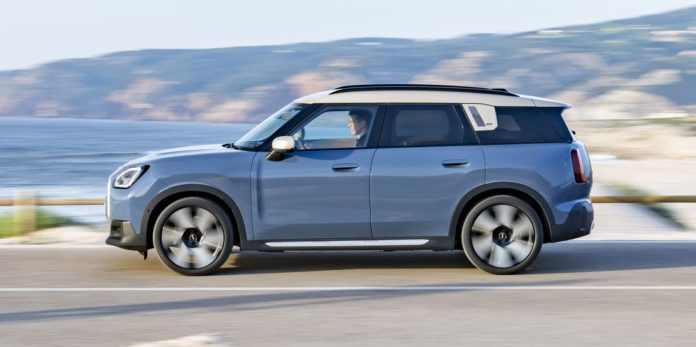The lobster, butter-soaked on many a plate, has more in common with cockroaches than the seafood restaurant would want you to believe—they share a common ancestor with many such freaks. Not to make anyone’s skin crawl, but the new all-electric Mini Countryman SE ALL4 wears a similar shell to the gas-powered Countryman, though it’s a very different bug.
Mini, which squashed the “Cooper” naming convention for the Countryman for this new generation, offers two versions of its all-electric SUV globally. North America is only getting this one, a dual-motor all-wheel-drive model (the powertrain also appears in the fully electric BMW iX2—another model we won’t get here). It has 308 horsepower, 107 more than the single-motor Countryman and just a few ponies less than the sporty John Cooper Works gas model. The EV produces 364 pound-feet of torque, which is nearly as much as a Porsche Macan S.
Mini claims that the all-wheel-drive Countryman SE ALL4 gets to 62 mph in 5.6 seconds, which wouldn’t put it among the quickest EVs today, but it would be in line with the acceleration performance of the Audi Q4 e-tron.
Electric Go-Kart
Our version of the electric Countryman gets a 64.6-kWh lithium-ion battery pack. It can be DC-fast charged at rates as high as 130 kilowatts. Mini says it can recharge from 10 to 80 percent in 29 minutes. For folks charging at home, the 11.0-kW onboard charger is enough to refill the Countryman SE ALL4 from 0 to 100 percent in a claimed seven hours or less.
The EPA hasn’t certified driving range yet, but a quick conversion of the Countryman’s European WLTP rating points to an EPA range of around 230 miles.
On paper, the all-electric Countryman’s specs are lacking when put up against the Mini’s closest competitor, the Volvo XC40 Recharge. The XC40 Recharge (renamed EX40 for the 2025 model year) comes standard with a higher peak DC fast-charge rate of 200 kilowatts and an EPA-estimated 293 miles of range. However, the Mini’s starting price is more amicable at $46,195—it’ll ring in $7550 below Volvo’s luxury electric SUV when it arrives in the U.S. in September.
Big Mini
We estimate the all-electric version to weigh 4600 pounds or approximately 800 pounds more than the gas-powered Countryman. Despite it sharing so much with the gas versions, the weight and powertrain differences lay especially heavy here. The JCW is all about swift and stiff dynamics, but the all-electric Countryman is all about being soft and quiet.
Both the gas and battery versions have fake noises plumbed into the sound system, but only the EV makes video-game spaceship sounds. There’s even a fun little sound effect during deceleration for “thruster cool down.” It can be fully defeated in the settings menu.
Unlike the gas-powered JCW, the electric Countryman doesn’t have paddle shifters (as its standard direct-drive transmission lacks any gears to shift between), but lift-off regen can be adjusted from too strong to way too strong by moving the gear selector from Drive to Braking.
While 17-inch wheels are standard, the Slate Blue Countryman SE ALL4 we drove was a mid-tier Exclusive-trim model wearing the optional 20-inch Windmill Spoke two-tone wheels wrapped in 245/40R-20 Pirelli P Zero all-season tires. Four-piston fixed calipers clamp vented discs up front, and single-piston floating calipers grab the vented rotors in the rear.
A Look Inside
The Countryman SE comes standard with a 9.4-inch round OLED touchscreen. Just like in a Tesla, the dashboard is all about propping up its giant screen, but the Mini’s interior is at least colorful and interesting, despite some cheap materials.
There is seating for five, and we found that the rear passenger space offers an excellent amount of headroom, but legroom might be an issue for taller passengers. There are vents, an armrest, two USB-C charge ports, and cupholders for folks riding back there, but only front passengers have climate controls. Cargo space is 51 cubic feet with the back seats folded and 16 cubic feet with them upright. That’s 5 and 9 cubic feet, respectively, less than the gas-powered Countryman, and the electric version gains no bonus cargo space as it lacks a frunk under the hood.
This fall, the all-electric Countryman SE ALL4 joins America’s simmering EV market as one of a handful of vehicles that also offers a gas-powered counterpart. (A smaller Mini Cooper Electric will arrive here early next year, but with less horsepower, a smaller battery, and likely less range.) Buyers can decide whether, for their lifestyle, an electric powertrain is pest or prawn.
Specifications
Specifications
2025 Mini Countryman SE ALL4
Vehicle Type: front- and rear-motor, all-wheel-drive, 5-passenger, 4-door wagon
PRICE
Base: SE ALL4, $46,195
POWERTRAIN
Front Motor: current-excited synchronous AC, 188 hp, 182 lb-ft
Rear Motor: current-excited synchronous AC, 188 hp, 182 lb-ft
Combined Power: 308 hp
Combined Torque: 364 lb-ft
Battery Pack: liquid-cooled lithium-ion, 64.6 kWh
Onboard Charger: 11.0 kW
Peak DC Fast-Charge Rate: 130 kW
Transmissions F/R: direct-drive
DIMENSIONS
Wheelbase: 106.0 in
Length: 174.5 in
Width: 72.6 in
Height: 64.4 in
Passenger Volume, F/R: 49–53/44 ft3
Cargo Volume, Behind F/R: 51/16 ft3
Curb Weight (C/D est): 4600 lb
PERFORMANCE (C/D EST)
60 mph: 5.3 sec
100 mph: 13.3 sec
1/4-Mile: 13.9 sec
Top Speed: 112 mph
EPA FUEL ECONOMY (C/D EST)
Combined/City/Highway: 103/110/95 MPGe
Range: 230 mi
Yes, he’s still working on the 1986 Nissan 300ZX Turbo project car he started in high school, and no, it’s not for sale yet. Austin Irwin was born and raised in Michigan, and, despite getting shelled by hockey pucks during a not-so-successful goaltending career through high school and college, still has all of his teeth. He loves cars from the 1980s and Bleu, his Great Pyrenees, and is an active member of the Buffalo Wild Wings community. When Austin isn’t working on his own cars, he’s likely on the side of the highway helping someone else fix theirs.

